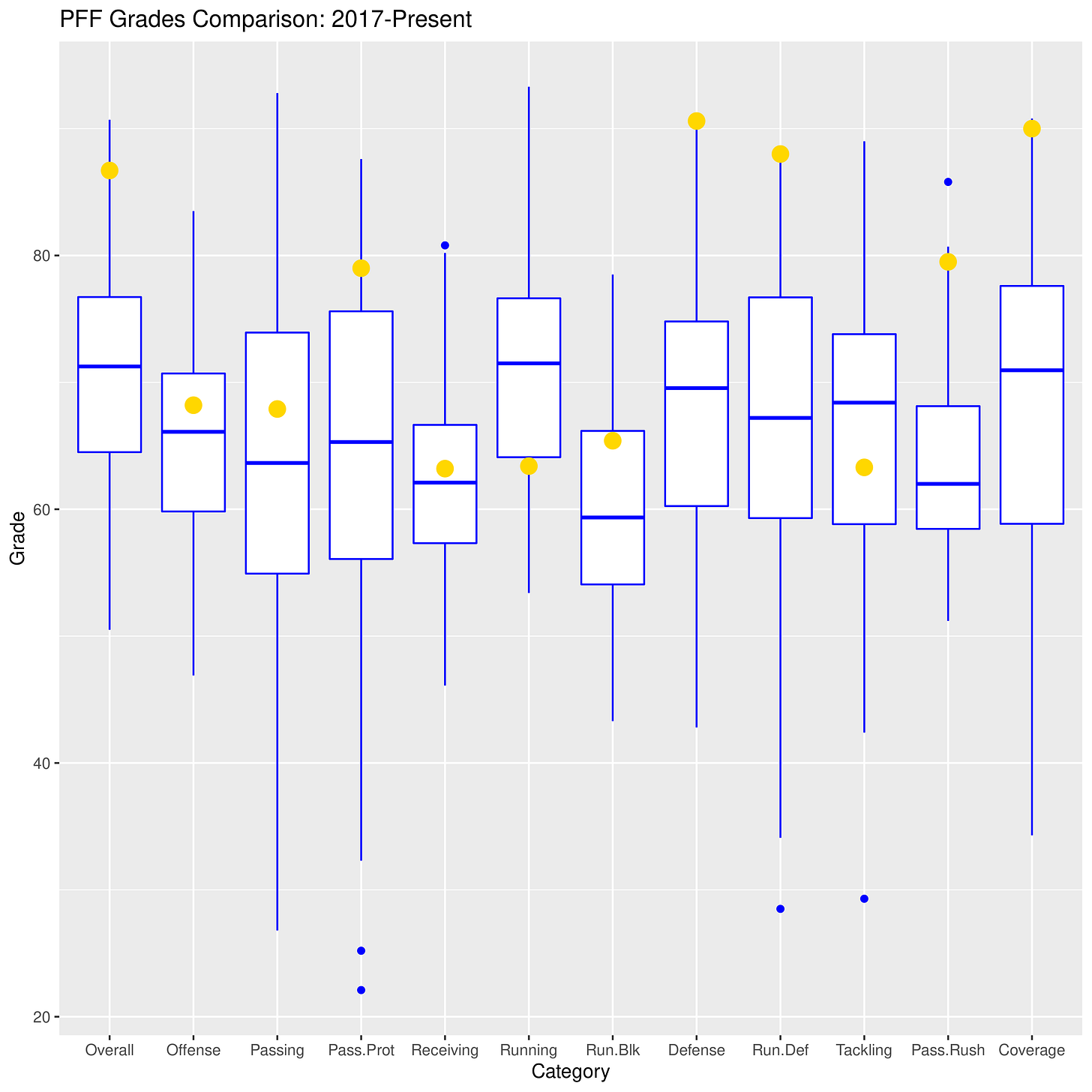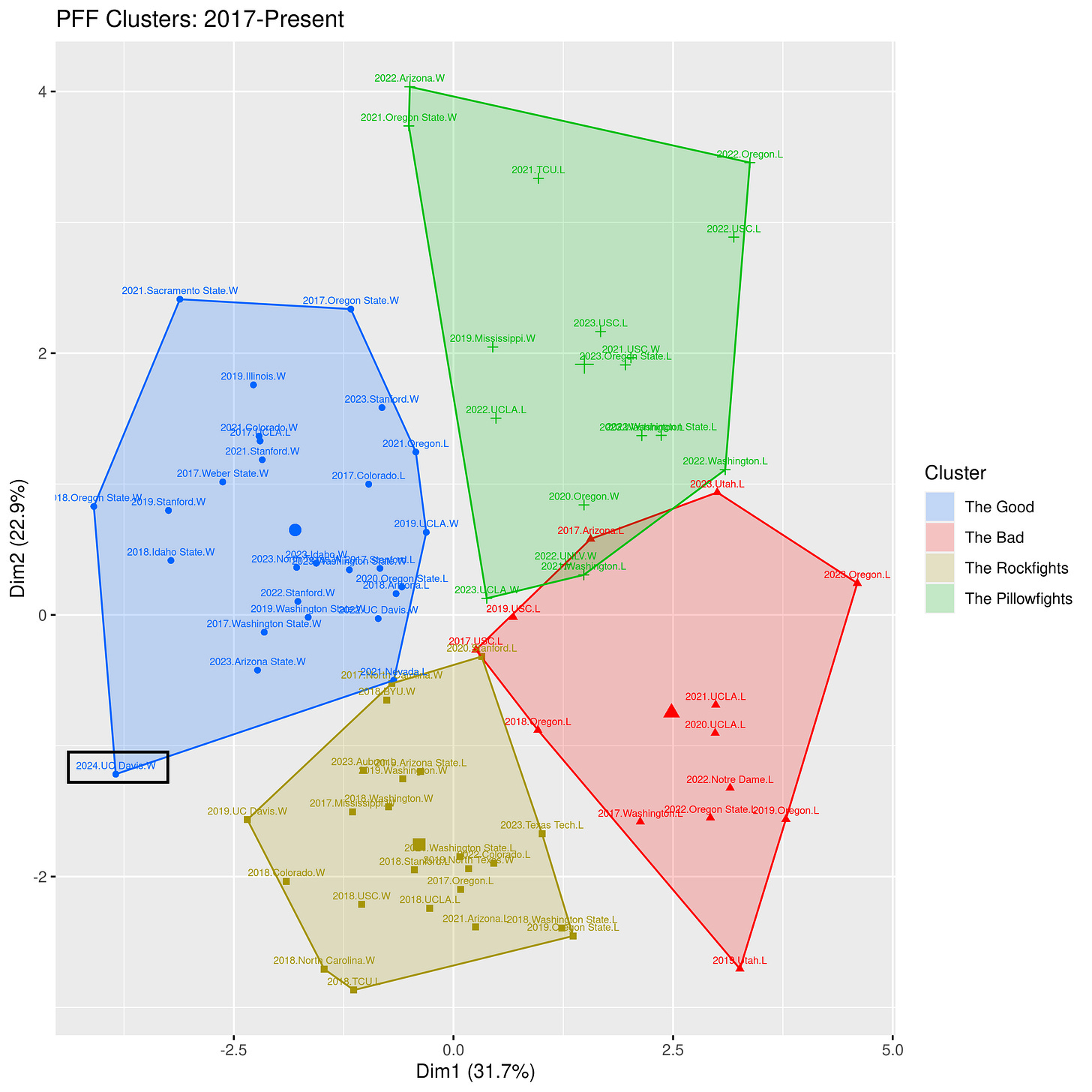The Good, the Bad, and the Rock Fights: Cal vs. UC Davis Football
After a slow start, the Bears kick off the season with a performance in The Good for the fourth year in a row.
Welcome to The Good, the Bad, and the Rockfights, our weekly series that uses grades from Pro Football Focus (PFF) to put the most recent Cal game into one of four buckets. PFF grades every player on every snap on everything from blocking assignments to missed tackles to route-running. In this series we focus primarily on the team grades, which cover thirteen categories:
Overall
Offense
Passing
Pass protection
Receiving
Running
Run blocking
Defense
Run defense
Tackling
Pass rush
Coverage
PFF grades these categories on a 0-100 scale where a 60 is a roughly average performance. We use a machine learning algorithm to sort through the statistics and group the games into clusters of similar performances (if you want to learn more about the analytic methods, see the appendix of this piece). In past data we have found four categories:
The Good: the Bears perform well across the board as most categories earn solid grades (examples: last year’s blowout win over North Texas and the 2019 Redbox Bowl win)
The Bad: the Bears fare poorly across most categories (examples: pretty much every time Cal plays in Salt Lake City or Pasadena)
Rockfights: The defense excels while the offense mostly struggles (examples: the Cheez It Bowl, the 2018 and 2019 wins over UW)
Pillow fights: The offense puts up a ton of yards while the defense struggles, especially against the opponent’s passing game (examples: the high-scoring losses to USC in 2022 and 2023). Fun fact: this category did not emerge until midway through the 2022 season because there had not been enough data to justify its existence until the defense started regressing badly from the first half of the Wilcox Era.
Now let’s review this week’s data.
PFF Grades Comparison
Below I show how last week’s grades (gold dots) compare to all the previous PFF grades we’ve seen under Wilcox. I represent this historic grades as boxplots. The box represents data between the 25th and 75th percentiles, while the horizontal line represents the median, or midpoint, of the data. tl;dr: gold dots above the box = great, gold dots in the upper portion of the box = good, gold dots in the lower portion of the box = bad, gold dots below the box = terrible.

Only two categories fared worse than usual, running and tackling. Everything else was better than usual. In fact, defense and run defense earned their highest scores of the Wilcox Era. Pass rush and coverage were just short of all-time highs. With loads of high-scoring categories, this game will fall in The Good, right?
PFF Clusters
We fed the results of the latest game into our machine learning algorithm and it returned a result in…The Good! The plot below visualizes the four clusters and the various games within them.

The Davis game fits in an odd position within The Good. Games closer together in the plot are more similar, while games farther apart are more dissimilar. Sitting on the edge of The Good not far from The Rockfights tells us that this game had a little bit of a Rockfight flavor to it. The first half certainly felt that way with many stalled drives from both teams and a single offensive touchdown. Fortunately a strong second-half performance from the defense (and a notable but still underwhelming improvement from the offense) helped move this one into The Good.
Odds and Ends
This year we’re adding some additional content to this series by highlighting a handful of specific PFF stats. Good, bad, in-between, individual-level, team-level…whatever catches my eye.
Offensive player of the game: WR Nyziah Hunter (PFF grade: 79.1), 48 yards and a TD on 4 receptions
Defensive player of the game: LB Cade Uluave (PFF grade: 89.8), 2 QB hurries, 7 tackles, 1 interception
Iron men (played every snap of the game): LB Cade Uluave, LB Teddye Buchanan, LT* Nick Morrow, LT* Rush Reimer, LG Bastian Swinney, RT TJ Session
*Both are listed as LTs but obviously they did not play the same position at the same time
QB competition update: Mendoza earned higher grades than Rogers in passing (70.6 vs. 57.6) and running (63.2 vs. 59.3); both earned a 60.0 in run blocking.
Leaky left: Heading into the season we knew the left side of the O-line would be a work-in-progress. Of the 10 disruptions allowed (including sacks, hits, hurries, and pressure), 8 came from the left side. Despite some issues on the left side, it was a good day for the line, as they avoided allowing sacks, hits, and hurries on 26 of 31 pass protection opportunities.
Pass rush (or lack thereof): Cal generated 11 QB hurries, 5 hits, and 0 sacks on 48 pass attempts. This means UC Davis was essentially unbothered on two-thirds of their pass attempts—not great.
Strong, solo tackling: The Bears amassed 45 tackles, and only 12 were assisted. And they only missed 8 tackles (unfortunately, half of those were from the safeties). It’s encouraging that players were consistently able to take care of business by themselves.
Programming note: While this piece is available to all readers this week, we typically keep this series behind the paywall because it relies on PFF stats and your subscriptions help us pay for access to PFF’s advanced stats. If you want to keep reading this series this season, please join as a paid subscriber. And if you’re already a subscriber, thank you!



*hoping Wilcox was keeping it vanilla and playing possum.